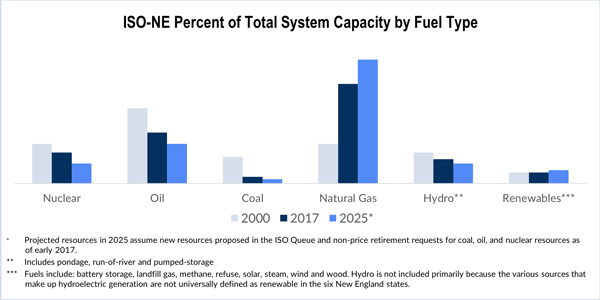By Michael Kuser
ISO-NE forecasts sufficient resources to meet demand for electricity this winter and will implement special operating procedures to maintain reliability in the event of higher-than-projected demand, unforeseen generator outages or natural gas supply constraints that squeeze gas-fired power plants.
The RTO on Thursday issued its 2017/2018 winter outlook, which forecast peak demand under various scenarios:
- 21,197 MW at normal winter low temperatures of about 7 F; and
- 21,895 MW in extreme winter weather dropping to 2 F.
Resources with Forward Capacity Market (FCM) supply obligations total 30,999 MW; including resources without FCM obligations, capacity totals 32,521 MW.
Last winter’s peak demand of 19,647 MW occurred on Dec. 15, 2016, between 5 and 6 p.m., while New England’s all-time winter peak of 22,818 MW occurred on Jan. 15, 2004.
Gas Concerns
The report highlighted “a continuing concern” that “the region’s natural gas delivery infrastructure has expanded only incrementally, while reliance on natural gas as the predominant fuel for both power generation and heating continues to grow.”
ISO-NE said 4,000 MW of natural gas-fired generating capacity is at risk of not being able to get fuel when needed.
The RTO said the retirement of the 1,500-MW coal- and oil-fired Brayton Point power plant in Somerset, Mass., in May removed a facility with stored fuel that helped meet demand when natural gas plants were unavailable.
The grid operator is again running its Winter Reliability Program, which provides incentives for demand-side resources and generators that stock up on oil or contract for LNG. The program, which runs from Dec. 1, 2017, through Feb. 28, 2018, will be replaced by new capacity market performance incentive rules that go into effect June 1, 2018.
Total energy consumption and peak demand have been flat in New England in recent years because of increased energy-efficiency measures and behind-the-meter solar photovoltaic (PV) systems. Both the normal and extreme peak demand forecasts include the 1,832 MW in energy savings from EE acquired through the capacity market. While PV helps reduce energy consumption during sunny winter days, demand peaks in winter after the sun has set. By reducing demand on sunny days, PV can help preserve other fuels for use when demand is peaking.




